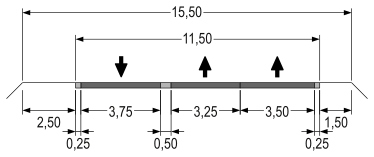Guidelines for the construction of roads - cross-section
| Basic data | |
|---|---|
| title | Guidelines for the construction of roads - Part: Cross-section |
| abbreviation | RAS-Q |
| number | 295 |
| scope of application | Street cross-sections |
| Previous edition | 1982 |
The guidelines for the construction of roads - Part: Cross-section ( RAS-Q for short ) was a technical set of rules valid in Germany for the construction and design of road cross-sections in Germany. They were published by the Research Association for Roads and Transport in Cologne. The last edition is from 1996.
The RAS-Q applied to all types of extra-urban roads until 2008 . With the introduction of the guidelines for the construction of motorways (RAA for short) in 2008, the motorway cross-sections were first re-regulated. In 2013, the guidelines for the construction of rural roads (RAL for short) came into force for rural road cross- sections, so that the RAS-Q are completely overridden.
In the guideline, width dimensions of different roads or their components were specified, such as those of the carriageway as well as the median and edge strips and the shoulder . Fixed cross-sections were defined for this purpose. Furthermore, depending on the traffic load, she suggested different standard cross-sections for the expansion of a road.
content
The content of the RAS-Q is divided into three sections. The first section serves as an introduction and shows the scope of the directive. In the second section the basics for the dimensions of the components of the road cross-section are defined. The cross-sectional design is then dealt with in section three.
There is also an appendix to the directive. Among other things, specifications are made there for the verification of the traffic quality and additional lanes on inclined roads.
Standard cross-sections
Single-lane standard cross-sections
- RQ 7.5 (width of the paved area is 5.5 meters)
Frequent cross-section on local roads or access roads in sparsely populated areas. Capability reaches up to 3000 vehicles, of which 60 are trucks per day.
- RQ 9.5 (width of the paved area is 6.5 meters)
Standard cross-section for country roads with a capacity of up to 15,000 vehicles, including 300 trucks per day.
- RQ 10.5 (width of the paved area is 7.5 meters)
Economical and efficient cross-section, which is usually used for federal highways. Up to 20,000 vehicles per day can be processed.
- RQ 15.5 (width of the paved area is 11.5 meters)
Similar to RQ 10.5, but with an additional lane on one side . The traffic quality on the road is better due to the reciprocal overtaking possibilities and safety is significantly increased. In hilly terrain, the overtaking options can be relocated in inclines, so that the performance is greater than with RQ 10.5 in the appropriate terrain. Also known as the 2 + 1 system .
Two-lane standard cross-sections
- RQ 20 (width of the paved area is 2 × 7.5 meters)
Saving cross-section for congested country roads, but nowhere near as efficient as the motorway cross-section, as there is no hard shoulder and narrower lane widths. Up to 30,000 vehicles, 4500 of which can be trucks per day.
- RQ 26 (width of the paved area is 2 × 10 meters)
Cross-section for low-traffic motorways and city motorways in confined spaces. Efficiency is between 20,000 and 60,000 vehicles per day.
Replaced in the RAA by the RQ 28. Difference to the RQ 26: each 0.5 m wider shoulder and 1 m wider median.
- RQ 29.5 (width of the paved area is 2 × 11.5 meters)
Standard cross-section for motorways with four lanes. Capacity up to 70,000 vehicles per day.
Replaced in the RAA by the RQ 31. Difference to the RQ 29.5: each 0.5 m wider side and median strips.
- RQ 33 (width of the paved area is 2 × 13.5 meters)
Slightly narrower than RQ 35.5 and therefore intended for six-lane motorway sections with a small proportion of trucks. Up to 80,000 vehicles per day and more are possible.
Deleted without replacement in the RAA.
- RQ 35.5 (width of the paved area is 2 × 14.5 meters)
Two-lane, six-lane motorway for the most heavily used motorway sections. Suitable for the range between 50,000 and 100,000 vehicles per day and a high proportion of trucks.
Replaced in the RAA by the RQ 36. Difference to the RQ 35.5: 0.5 m wider median.
See also
Web links
- Table of contents of the RAS-Q at FGSV-Verlag (PDF file; 210 kB) (no longer available at this link)








